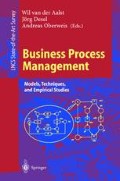Abstract
Automatic analysis techniques for business processes are crucial for today’s workflow applications. Since business processes are rapidly changing, only fully automatic techniques can detect processes which might cause deadlocks or congestion.
Analyzing a complete workflow application, however, is much too complex to be performed fully automatically. Therefore, techniques for analyzing single processes in isolation and corresponding soundness criteria have been proposed. Though these techniques may detect errors such as deadlocks or congestion, problems arising from an incorrect interoperation with other processes are completely ignored. The situation becomes even worse for cross-organizational workflow applications, where some processes are not even available for analysis due to confidentiality reasons.
We propose a technique which allows to detect but a few errors of workflow applications which arise from incorrect inter-operation of workflows. To this end, the dynamics of the inter-operation of different workflows must be specified by the help of sequence diagrams. Then, each single workflow can be checked for local soundness with respect to this specification. If each single workflow is locally sound, a composition theorem guarantees global soundness of the complete workflow application. This way, each organization can check its own workflows without knowing the workflows of other organizations—still global soundness is guaranteed.
Access this chapter
Tax calculation will be finalised at checkout
Purchases are for personal use only
Preview
Unable to display preview. Download preview PDF.
References
Eike Best and César Fernández. Nonsequential Processes, EATCS Monographs on Theoretical Computer Science 13. Springer-Verlag, 1988.
Peter Graubmann, Ekkart Rudolph, and Jens Grabowski. Towards a Petri net based semantics definition for message sequence charts. In O. Færgemand and A Sarma, editors, SDL’ 93 Using Objects, proceedings of the Sixth SDL Forum, pages 415–418. North-Holland, October 1993.
ITU-T Recommendation Z.120. Message sequence charts (MSC). ITU, 1996.
Cliff. B Jones. Specification and design of (parallel) programs. In R.E.A Mason, editor, Information Processing, pages 321–332. IFIP, Elsevier Science Publishers B.V. (North Holland), 1983.
Ekkart Kindler and Wolfgang Reisig. Algebraic system nets for modelling distributed algorithms. Petri Net Newsletter, 51:16–31, December 1996.
Ekkart Kindler. A compositional partial order semantics for Petri net components. In Pierre Azéma and Gianfranco Balbo, editors, Application and Theory of Petri Nets, 18 th International Conference, LNCS 1248, pages 235–252. Springer-Verlag, June 1997.
James Rumbaugh, Ivar Jacobsen, and Grady Booch. The Unified Modeling Language Reference Manual. Object Technology Series. Addison Wesley, 1999.
W.M.P. van der Aalst. Exploring the process dimension of workflow management. Computing Science Reports 97/13, Eindhoven University of Technology, September 1997.
W.M.P. van der Aalst. Verification of workflow nets. In P. Azéma and G. Balbo, editors, Application and Theory of Petri Nets, LNCS 1248, pages 407–426. Springer-Verlag, June 1997.
W.M.P van der Aalst. Interorganizational workflows: An approach based on Message Sequence Charts and Petri nets. Systems — Analysis — Modelling — Simulation, 34(3):335–367, 1999.
Author information
Authors and Affiliations
Editor information
Editors and Affiliations
Rights and permissions
Copyright information
© 2000 Springer-Verlag Berlin Heidelberg
About this chapter
Cite this chapter
Kindler, E., Martens, A., Reisig, W. (2000). Inter-operability of Workflow Applications: Local Criteria for Global Soundness. In: van der Aalst, W., Desel, J., Oberweis, A. (eds) Business Process Management. Lecture Notes in Computer Science, vol 1806. Springer, Berlin, Heidelberg. https://doi.org/10.1007/3-540-45594-9_15
Download citation
DOI: https://doi.org/10.1007/3-540-45594-9_15
Published:
Publisher Name: Springer, Berlin, Heidelberg
Print ISBN: 978-3-540-67454-2
Online ISBN: 978-3-540-45594-3
eBook Packages: Springer Book Archive

